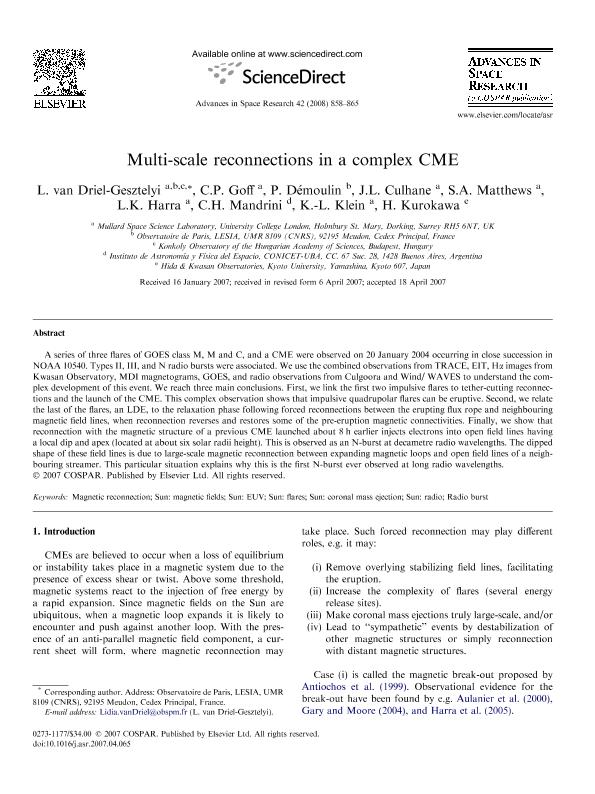Artículo
Multi-scale reconenctions in a complex CME
van Driel Gesztelyi, Lidia; Goff, C. P.; Démoulin, Pascal; Culhane, J. L.; Matthews, S. A.; Harra, L. K.; Mandrini, Cristina Hemilse ; Klein, K. L.; Kurokawa, H.
; Klein, K. L.; Kurokawa, H.
 ; Klein, K. L.; Kurokawa, H.
; Klein, K. L.; Kurokawa, H.
Fecha de publicación:
09/2008
Editorial:
Elsevier
Revista:
Advances in Space Research
ISSN:
0273-1177
Idioma:
Inglés
Tipo de recurso:
Artículo publicado
Clasificación temática:
Resumen
A series of three flares of GOES class M, M and C, and a CME were observed on 20 January 2004 occurring in close succession in NOAA 10540. Types II, III, and N radio bursts were associated. We use the combined observations from TRACE, EIT, Ha images from Kwasan Observatory, MDI magnetograms, GOES, and radio observations from Culgoora and Wind/ WAVES to understand the complex
development of this event. We reach three main conclusions. First, we link the first two impulsive flares to tether-cutting reconnections and the launch of the CME. This complex observation shows that impulsive quadrupolar flares can be eruptive. Second, we relate the last of the flares, an LDE, to the relaxation phase following forced reconnections between the erupting flux rope and neighbouring magnetic field lines, when reconnection reverses and restores some of the pre-eruption magnetic connectivities. Finally, we show that reconnection with the magnetic structure of a previous CME launched about 8 h earlier injects electrons into open field lines having a local dip and apex (located at about six solar radii height). This is observed as an N-burst at decametre radio wavelengths. The dipped shape of these field lines is due to large-scale magnetic reconnection between expanding magnetic loops and open field lines of a neighbouring streamer. This particular situation explains why this is the first N-burst ever observed at long radio wavelengths.
Palabras clave:
Sun: Corona
,
Sun: Coronal Mass Ejections
,
Sun: Flares
Archivos asociados
Licencia
Identificadores
Colecciones
Articulos(IAFE)
Articulos de INST.DE ASTRONOMIA Y FISICA DEL ESPACIO(I)
Articulos de INST.DE ASTRONOMIA Y FISICA DEL ESPACIO(I)
Citación
van Driel Gesztelyi, Lidia; Goff, C. P.; Démoulin, Pascal; Culhane, J. L.; Matthews, S. A.; et al.; Multi-scale reconenctions in a complex CME; Elsevier; Advances in Space Research; 42; 5; 9-2008; 858-865
Compartir
Altmétricas



